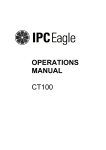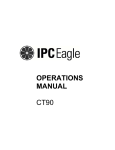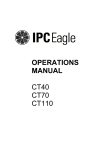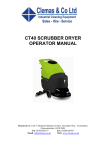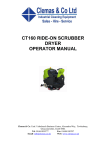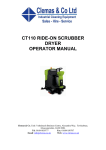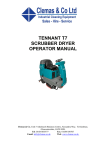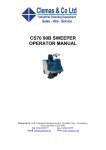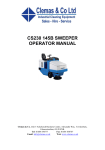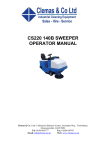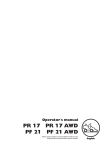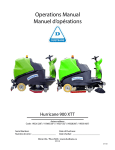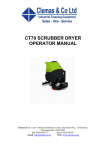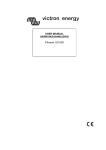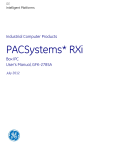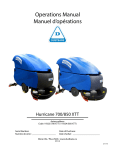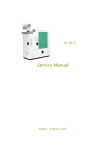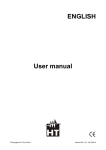Download ct100 pedestrian scrubber dryer operator manual
Transcript
CT100 PEDESTRIAN SCRUBBER DRYER OPERATOR MANUAL Clemas & Co. Unit 5 Ashchurch Business Centre, Alexandra Way, Tewkesbury, Gloucestershire, GL20 8NB. Tel: 01684 850777 Fax: 01684 850707 Email: [email protected] Web: www.clemas.co.uk ENGLISH (Translation of original instructions) 1. TABLE OF CONTENTS 1. TABLE OF CONTENTS ....................................................................................................... 2 2. GENERAL INFORMATION .................................................................................................. 4 2.1 2.2 2.3 3. 3.1 3.2 3.3 3.4 3.5 3.6 4. 4.1 5. SCOPE OF THE MANUAL....................................................................................................... 4 IDENTIFICATION OF THE MACHINE......................................................................................... 5 DOCUMENTATION ANNEXED TO THE MACHINE ....................................................................... 5 TECHNICAL INFORMATION............................................................................................... 5 GENERAL DESCRIPTION ...................................................................................................... 5 LEGEND ............................................................................................................................. 5 DANGER AREAS .................................................................................................................. 6 SAFETY DEVICES ................................................................................................................ 6 OPTIONAL UNITS ................................................................................................................. 6 ACCESSORIES .................................................................................................................... 6 INFORMATION ON SAFETY ............................................................................................... 7 SAFETY STANDARDS ........................................................................................................... 7 HANDLING AND INSTALLATION ....................................................................................... 9 5.1 LIFTING AND CARRYING THE PACKED MACHINE ..................................................................... 9 5.2 CHECKING THE MACHINE ON DELIVERY ................................................................................ 9 5.3 UNPACKING ........................................................................................................................ 9 5.4 FEEDING BATTERIES ......................................................................................................... 10 5.4.1 Batteries: preparation................................................................................................. 10 5.4.2 Batteries: installation and connection......................................................................... 11 5.4.3 Batteries: removal ...................................................................................................... 11 5.5 THE BATTERY-CHARGER ................................................................................................... 12 5.5.1 Choosing the battery-charger..................................................................................... 12 5.5.2 Preparing the battery-charger .................................................................................... 12 5.6 LIFTING AND HANDLING THE MACHINE ................................................................................ 12 6. PRACTICAL GUIDE FOR THE USER ............................................................................... 12 6.1 CONTROL DEVICES - DESCRIPTION .................................................................................... 12 6.2 INSTALLING AND ADJUSTING THE SQUEEGEE ...................................................................... 13 6.3 MOVING THE MACHINE ...................................................................................................... 14 6.4 INSTALLING AND REPLACING THE BRUSHES / DRIVE DISCS / ROLLERS ................................... 14 6.4.1 Brush head (models 60-70-80) .................................................................................. 14 6.4.2 Roller head (roller models R) ..................................................................................... 14 6.4.3 Flap adjustment.......................................................................................................... 15 6.5 DETERGENTS - USE .......................................................................................................... 15 6.6 SETTING UP THE MACHINE ................................................................................................. 15 6.7 W ORK .............................................................................................................................. 16 6.7.1. Additional functions................................................................................................ 17 6.8 SOME USEFUL SUGGESTIONS FOR THE OPTIMAL USE OF THE MACHINE ................................ 17 6.8.1 Pre-washing ............................................................................................................... 17 6.8.2 Drying......................................................................................................................... 18 6.9 DRAINING OFF DIRTY WATER ............................................................................................. 18 6.10 DRAINING OFF CLEAN WATER ............................................................................................ 18 7. PERIODS OF INACTIVITY................................................................................................. 19 8. MAINTENANCE AND BATTERY RECHARGING ............................................................. 19 8.1 9. RECHARGING PROCEDURES .............................................................................................. 19 INSTRUCTIONS FOR MAINTENANCE............................................................................. 20 9.1 MAINTENANCE – GENERAL RULES ..................................................................................... 20 9.2 ROUTINE MAINTENANCE .................................................................................................... 20 9.2.1 Precautions ................................................................................................................ 20 9.2.2 Suction air filter and floating rod: cleaning ................................................................. 20 9.2.3 Squeegee blades: check and replacement ................................................................ 20 2 ENGLISH 9.2.4 Fuses: replacement.................................................................................................... 21 9.3 PERIODIC MAINTENANCE ................................................................................................... 22 9.3.1 Daily maintenance...................................................................................................... 22 9.3.2 Weekly maintenance.................................................................................................. 22 9.3.3 Basket filter: cleaning ................................................................................................. 22 9.3.4 Six-monthly maintenance........................................................................................... 22 10. HOW TO ORDER SPARE PARTS ................................................................................ 22 11. TROUBLESHOOTING................................................................................................... 24 11.1. HOW TO OVERCOME POSSIBLE FAILURES ........................................................................... 24 ENGLISH 3 2. GENERAL INFORMATION Read this manual carefully before starting any operations on this machine1. 2.1 Scope of the manual This manual has been drawn up by the Manufacturer and is considered as an integral part of the machine. It defines the purpose for which the machine has been manufactured and contains all information the operators2 require. Besides this manual, which contains the necessary information for the users, other publications have been issued, which contain the specific information for the technicians in charge of maintenance3. The constant observance of the instructions guarantee the safety of man and machine, low running costs, quality results and a longer work life of the machine itself. The nonobservance of the prescribed rules could injure men, damage the machine, spoil the washed floor and even the environment. To find the single topics in a fast way, see the descriptive table of contents at the beginning of this manual. The paragraphs that are not to be neglected are printed in bold letters and preceded by symbols illustrated and defined below. ! DANGER Indicates that attention must be paid to avoid serious consequences that could cause the death of the personnel or possible damages to health. WARNING Indicates that attention must be paid to avoid serious consequences that could damage the machine, spoil the environment where the machine is used or cause economic losses. i INFORMATION Particularly important instructions. In following a policy of constant development and update of the product, the Manufacturer could implement modifications without any previous notice. Even though the machine you own is greatly different from the one(s) illustrated in this manual, safety and information thereof are guaranteed anyway. 1 The definition "machine" substitutes the commercial name to which this manual refers. 2 People authorised to use the machine without carrying out maintenance operations that require precise technical knowledge. 3 People having the experience, technical preparation and knowledge of the regulations and laws necessary to carry out the activity and capable to recognize and avoid possible dangers when handling, installing, using the machine and carrying out maintenance operations. 4 ENGLISH 2.2 Identification of the machine The number plate (fig. 1), which is attached at the rear of the machine, shows the following information: • model code; • machine model; • power supply voltage; • total rated power; • serial number (registration number); • year of manufacture; • dry weight; • maximum full load weight; • steepest slope that can be overcome; • bar code with serial number; • Manufacturer’s identification. 2.3 • • • • • Documentation annexed to the machine User's Manual; warranty certificate; adhesive slips for spare part orders; test sheet; CE Certificate of conformity. 3. 3.1 TECHNICAL INFORMATION General description The machine is a sweeping scrubber, which can be used in civil and industrial environments for sweeping, washing and drying flat, horizontal, smooth or moderately rough floors, with even surfaces and free from obstacles. The scrubber distributes on the floor an adequately dosed solution of water and detergent, and brushes it to remove dirt. Choosing with care the right cleaning detergent and brushes (or abrasive discs or roller) in the wide range of accessories available, the machine can adapt itself to all kinds of combinations of floors and dirt. A liquid suction system, which is embedded in the machine, allows a perfect drying of the just-washed floor: actually thanks to a suction unit which sucks up the air from the recovery tank thus creating a vacuum, the squeegee scrapes the dirty water from the floor, collects it and sends it to the recovery tank. The storage battery feeding and the high capacity of usable batteries allow the maximum freedom of movement and endurance at any work conditions. In addition, thanks to the electronic control drive motor provided with forward and reverse gear, the floor can easily be cleaned in any direction. 3.2 Legend The main components of the machine are the following (fig. 2): • the detergent solution tank (fig. 2, ref. 3): used to contain and carry the mixture of clean water and detergent; • the recovery tank (fig. 2, ref. 2): used to collect dirty water sucked up from the floor during washing; • control panel (fig. 2, ref. 1); • head unit (fig. 2, ref. 5): the main element is represented by the brushes/rollers, which distribute the detergent solution on the floor, removing dirt; • drive unit (fig. 2, ref. 7): the main element consists of the electronically controlled gearmotor which is operated via a lever below the machine handgrip and enables the machine to move forward and back; ENGLISH 5 • squeegee unit (or floor wiper, fig. 2, ref. 8): used to wipe and dry the floor, sucking up the water spread on the floor; • battery unit (fig. 2, ref. 6): supplies energy for the machine feeding; • bonnet (fig. 2, ref. 4). 3.3 Danger areas A -Tank unit: in presence of certain detergents, danger of irritation for the eyes, skin, mucous diaphragms, respiratory apparatus and asphyxia. Danger caused by dirt recovered from the environment (germs and chemical subtances). Danger of crushing between the recovery tank and solution tank, when the recovery tank is replaced on the solution tank. B -Control panel: danger of shortcircuits. C -Lower part of washing head: danger due to lowering of head and rotation of brushes/rollers. D -Top of washing head: danger of crushing between the top of the brush head and the chassis. E -Rear wheels: danger of crushing between wheel, chassis and tank. F - Electrical components box: danger of short circuits. G -Battery compartment (located within the solution tank): danger of short circuits between the battery poles and presence of hydrogen during battery charging. 3.4 Safety devices A B - C 3.5 DEVICE (fig. 3) Emergency button ACTIVATION Made active when pressed. Safety in reverse Safety device to prevent crushing in reverse. Cuts in when pressed. Service brake Comes on automatically when the drive lever is released. Parking and emergency Press pedal C to brake engage. Must be operated only with the machine at a standstill or in case of emergency: if operated with the machine moving, it can cause damage. FUCTION Interrupts the power supply. Interrupts reverse movement of machine. The machine gradually decelerates. Prevents the machine moving. Optional units Hour counter: the hour counter accessory is fixed to the control panel (fig. 4, ref. 1). It displays the number of brush operating hours. 3.6 • • • • 6 Accessories Bristle brushes/rollers: used for washing delicate floors and for polishing; Polipropilene brushes/rollers: used for normal floor washing; Tynex brushes/rollers: used to remove accumulated stubborn dirt on resistant floors; Drive discs: allow the use of the following discs: ∗ yellow discs: used for washing and polishing marble and similar surfaces; ∗ green discs: used for washing of resistant floors; ∗ black discs: used for thorough washing of resistant floors with stubborn dirt. ENGLISH 4. 4.1 INFORMATION ON SAFETY Safety standards Read the User's manual carefully before proceeding with start-up, use, maintenance, routine maintenance or any other operations on the machine. WARNING Stick to all the instructions contained in this Manual (especially those regarding danger and warning) and observe the safety plates attached on the machine. The Manufacturer declines all responsibility for injures to persons or damage to things deriving from the non-observance of these instructions. The machine must be used by trained personnel only, who have shown their skill and have been expressly authorized to use it. Persons under eighteen cannot use the machine. This machine must not be used for any other purpose than that for which it has been expressly manufactured. Assess the type of building in which it will be used (e.g. pharmaceutical and chemical companies, hospitals, etc.) and scrupulously respect the regulations and conditions in force. Do not use the machine in places that are not adequately lighted, in environments with danger of explosions, on public roads, in the presence of dirt harmful to health or improper environments. The suitable temperature for the use of the machine ranges between +4°C and +35°C; when the machine is not used, the temperature range is between +0°C e +50°C. The humidity range for the machine under any conditions varies between 30% and 95%. Never use or suck up inflammable or explosive liquids (e.g. petrol, fuel oil, etc.), inflammable gases, dry dust, acids and solvents (e.g. solvents for paints, acetone, etc.) even if diluted. Never suck up any burning or white-hot objects. Do not use the machine on slopes or ramps higher than 2%; in the event of light slopes do not use it transversally, handle it with extreme care and do not reverse. When driving along ramps or heavier slopes take great care to avoid overturning or uncontrolled acceleration. Overcome ramps and/or steps exclusively with the brush head and squeegee lifted. Never park the machine on slopes. The machine must never be left unmanned with the motors running; before abandoning the machine, switch the motors off, ensure that it cannot move accidentally, engage the parking brake and remove the key from the ignition. When using the machine mind the presence of people particularly children in the environment where you are working. Do not use the machine to carry persons/things or to tow things. Do not drag the machine. Never lay things on the machine for any reason. Do not obstruct the air vents and heat dispersion openings. Do not remove, modify or elude the safety devices. Various and unpleasant experiences have shown that people wear or carry various objects capable of causing serious accidents: before starting to work, remove trinkets, watches, neckties or other such things. Always use individual safety protections: apron or protective suit/overalls, non-slip waterproof shoes, rubber gloves, protective goggles and caps, face mask to protect the respiratory system. ENGLISH 7 Do not put the hands in between moving organs. Do not use detergents different from those provided for, and stick to the instructions indicated on the respective safety sheets. Keep detergents in a safe place, inaccessible to children, and in case they come in contact with the eyes, wash them immediately with plenty of water or, if swallowed, call for a doctor immediately. Make sure that the plugs for the power supply of the models with cable or of the batterychargers are properly grounded and protected by magnetothermal switches and differentials. Make sure that the electric characteristics of the machine (voltage, frequency, absorbed power) indicated on the identification plate (fig. 1), are compliant with those of the power distribution plant. The machine with cable is equipped with three lead wires and a threecontact ground plug for the use of a proper grounding plug. The yellow and green wire of the cable is the earth wire: never connect this wire to other wires that are not the plug ground tap. It is fundamental to observe the battery Manufacturer’s instructions and stick to the Legislator’s provisions. Keep batteries always dry and clean to avoid surface leakage currents. Keep batteries safe from impurities, for instance metal dust. Do not lay tools on batteries: danger of short circuits and explosions. Mind the use of battery acid: stick to the relative safety instructions. When using the machine model with cable mind that you do not crush or tear the power supply cable. Check this cable periodically to control if it is damaged; if this is so, the machine cannot be used. In presence of particularly high magnetic fields assess the possible effects on the control electronics. Never wash the machine with jets of water. The recycled fluids contain detergents, disinfectants, water, organic and inorganic stuff recycled during the work stages: they must be disposed of in compliance with the laws in force. In case of breakdown and/or bad operation of the machine, switch it off immediately (unplugging it from the mains) and do not tamper with it. Contact a technical assistance centre of the Manufacturer’s. All maintenance operations must be performed in adequately lighted environments and only after having disconnected the machine from the power supply (in models with cable by unplugging the machine from the socket, while in models with battery by detaching the battery connector). Have any electrical work and all maintenance and repair operations (particularly those not explicitely described in this manual) carried out a specialised and trained technical staff only. In case of replacement of the power supply cable, plug or terminals, perform the repair by properly fixing the electric connections and the cable blocking strap that is located in the control panel, to guarantee the resistance of the cable. Then reassemble the panel with care to ensure the protection of the machine user. Only the use of original accessories and spare parts supplied by the Manufacturer is permitted, as only these offer the certainty that the machine will operate safely and without any inconveniences. Do not use parts removed from other machines or other kits as spares. This product is classified as RAEE type special waste and is covered by the requisites of the new environmental protection regulations (2002/96/CE RAEE). It must be disposed of separately from ordinary waste in compliance with current legislation and standards. Special waste. Do not dispose of with ordinary waste. 8 ENGLISH Alternatively, the machine can be sent to the Manufacturer for a thorough overhaul. If the machine is not used anymore, it is recommended that batteries are removed and deposited at an authorized collecting centre. Moreover, it is recommended that you make harmless those parts of the machine that could be dangerous especially to children, who could use the machine for their games. 5. 5.1 HANDLING AND INSTALLATION Lifting and carrying the packed machine WARNING In all lifting operations make sure that the packed machine has been tightly anchored to the pallet, in order to avoid any overturning or accidental falls. Loading and/or unloading from the motor vehicles must be performed in an adequately lighted environment. The machine, which is packed on a wooden pallet by the Manufacturer, must be loaded by means of proper handling machines (refer to the EEC provision 89/392/CEE and following amendments), onto the carrier and, once it has arrived at the appointed destination, unloaded by similar means. The brushes and the squeegees are packed in cardboard boxes without pallet. The packed machine body must be lifted only with a fork lift truck. Handle with care to avoid bumps or overturnings. 5.2 Checking the machine on delivery On delivery check with attention that the package and the machine are not damaged. In the event that the machine has suffered any damages, report so to the carrier; before accepting the goods, reserve by written the right to present a claim for the refund of the damages. 5.3 Unpacking WARNING On unpacking the machine, the operator must be provided with the necessary accessories (e.g. gloves, protective goggles etc.) to limit possible hazards of accidents. Unpack the machine in the following way: • cut and remove the plastic straps with scissors or nippers; • remove the cardbox; • remove the envelopes inside the battery compartment (within the solution tank) and check its contents: envelope 1: - test sheet; - warranty coupon; - user’s and maintenance manual; envelope 2: - 3 battery bridge with clips; - 1 pair of tweezers for fuses; - 1 connector for the battery-charger; - 2 switch keys; i INFORMATION Keep one of the 2 keys safe so that it can be located in case the other one is lost; the other key is to be inserted in the lock on the mushroom switch. • depending on the model, remove the metal brackets or cut the plastic straps, which fix the machine chassis to the pallet; ENGLISH 9 • disengage the parking brake via the pedal ref. C fig. 3; • let the machine slide down the pallet on an inclined plane, by pushing it into reverse; • unwrap the brushes/rollers (fig. 5, ref. 1) and the squeegee (fig. 5, ref. 2) from their packing; • clean the outside of the machine observing the safety rules; • after unpacking the machine, you can install the batteries: see respective paragraphs. If necessary, preserve the wrapping material as it could be used again to protect the machine in the event of a move or if the machine should be sent to a service centre for repair. Otherwise, the material must be disposed of in compliance with the laws in force. 5.4 Feeding batteries Two different batteries can be fitted on this machine: • Tubular leak-proof batteries: these batteries require the periodical check of the electrolyte level. When it is necessary, top up with distilled water alone until the plates are covered; do not overfill (max. 5 mm. above the plates). • Gel batteries: this kind of batteries requires no maintenance. When using this type of battery the fuse FU7 (fig. 6, ref. 2) inside the machine control panel must be removed using the pliers. This operation serves to inform the electronic control of the type of battery used. WARNING Do not fit the fuse FU7 if using gel batteries. The technical specifications must correspond to those indicated in the paragraph concerning the machine technical data: actually, the use of heavier storage batteries can cause serious problems to the machine controllability and overheat the drive motor, whereas storage batteries with a lower capacity require recharges more frequently. They must be kept charged, dry and clean, with their connections tight. 5.4.1 Batteries: preparation ! DANGER On installing or performing any kind of maintenance on the batteries wear the necessary accessories (e.g. protective gloves, goggles, overalls, etc.) to limit the hazards of accidents, keep away from possible free flames, do not short-circuit the battery poles, cause sparks or smoke. The batteries are normally supplied filled with acid and ready-for-use. If batteries without acid are to be used, before mounting them on the machine, it is necessary to make them active as follows: • after taking off the battery plugs, fill up all elements with a solution of specific sulphuric acid, until the cells are thoroughly covered (fill each element at least twice); • let them rest for about 4-5 hours, to give time to air bubbles to come up to the surface and the plates to absorb the electrolyte; • check that the electrolyte level is still above the plates, otherwise top up with the solution of sulphuric acid; • reclose the plugs; • install the storage batteries on the machine (following the procedure described below). It is now necessary to perform a first recharging before having the machine start; to do so stick to the instructions written in the respective paragraph. 10 ENGLISH 5.4.2 Batteries: installation and connection ! DANGER Check that the emergency button on the control panel is at the position “0” (off). Mind you connect only the clips marked with the symbol “+” to the positive poles. Do not check the battery charge by creating sparkles. Stick scrupulously to the instructions described below, as any short circuits of the batteries may cause them to explode. 1) Stop the machine and press the emergency button (fig. 8, ref. 2); engage the parking brake by means of the pedal (fig. 8, ref. 12); 2) make sure that the two tanks are empty (empty them, if necessary: see respective paragraph); 3) unhook the recovery tank (fig. 2, ref. 2) from the solution tank (fig. 2, ref. 3) acting on the blocking hook (fig. 7, ref. 1), placed on front of the machine; 4) lift the recovery tank, by making it turn backwards around about 90°: in this way you have access to the battery compartment (embedded in the solution tank) from the upper side; WARNING Before opening the upper tank: ensure that the recovery tank is empty (an acoustic warning device will sound if you try to open the recovery tank without emptying it first); ensure that the emergency button is pressed. 5) insert the batteries in the compartment, orienting them as shown in the drawing printed on the solution tank in the compartment. WARNING Install the storage batteries on the machine using suitable means according to their weight. Positive and negative poles have different diameters. 6) Referring to the arrangement of cables in the aforesaid drawing, connect the clips of the battery wiring and the bridge to the poles of the storage batteries. After orienting the cables as shown in the drawing, tighten the clips at the poles and cover them with vaseline; 7) insert back the tank unit in its work position and hook it to the solution tank by means of the fixing hook (fig. 7, ref. 1); 8) use the machine in compliance with the instructions written below. 5.4.3 Batteries: removal ! DANGER When removing the batteries, the operator must be equipped with suitable personal protection devices (gloves, goggles, overalls, safety shoes, etc) to reduce the risk of accidents. Make sure the switches on the control panel are in the "0" position (off) and the machine is turned off. Keep away from naked flames, do not short circuit the battery poles, do not cause sparks and do not smoke. Proceed as follows: • disconnect the battery wiring and bridge terminals from the battery poles. • if necessary, remove the devices fixing the battery to the base of the machine. • lift the batteries from the compartment using suitable lifting equipment. ENGLISH 11 5.5 The battery-charger WARNING Never let the batteries run down excessively, as they could become damaged irreparably. WARNING Before recharging the batteries, ensure that you have pressed the emergency button. 5.5.1 Choosing the battery-charger Check that the battery-charger is compatible with the batteries to be charged: − tubular lead batteries: an automatic battery-charger 24V - 20A is suggested. Anyway, refer to the Manufacturer and read the relative manual to confirm your choice; − gel batteries: use a battery-charger specifically intended for this type of storage batteries. 5.5.2 Preparing the battery-charger If you wish to use a battery-charger not supplied with the machine, it is necessary to mount on it the connector delivered with the machine (see paragraph “Unpacking” of this manual). To install the connector proceed as follows: • remove about 13 mm of sheath from the black and red cables of the battery-charger; • insert the cables in the connector pins and push strongly with suitable pliers; • insert the cables in the connector respecting the polarity (red cable +, black cable –). 5.6 Lifting and handling the machine WARNING All stages must be performed in an adequately lighted environment adopting all necessary safety measures. Always wear individual protections for the user’s safety. The loading of the machine onto a vehicle must be done as follows: • empty the recovery tank and the solution tank; • remove the squeegee and the brushes (or drive discs); • remove the batteries; • place the machine on the pallet, engage the parking brake and secure it with plastic straps or metal brackets; • lift the pallet by means of a fork lift truck and load it on the vehicle; • anchor the machine to the vehicle with ropes connected to the pallet and to the chassis of the machine. 6. 6.1 PRACTICAL GUIDE FOR THE USER Control devices - Description With reference to fig. 8 the machine has the following controls and leds: • Battery charge level indicator (ref. 9): signals both “Power on” and the battery charge level. Note: the following percentages are based on the usable capacity and not the total capacity of the batteries (therefore 100% flat = 80% of total battery capacity). Possible situations are: a) off: the main switch is set to “0” (off) or the batteries are disconnected; b) green light: batteries charged from 100% to 50%; c) yellow light: batteries charged from 50% to 15%; d) red light (also simultaneously with yellow or green light): batteries flat and 12 ENGLISH • • • • • • • • • • 6.2 must be recharged. Main switch - emergency button with key (ref. 2): enables or disables the power supply to all the machine functions. It acts as a safety device. To start the machine turn the proper key clockwise. To stop the machine press the button. Brush/roller up-down button (ref. 5): when the arrow down is pressed, the head moves down to the working position, the brush motor comes on automatically and the solenoid valve is activated. Via this button, a variable pressure can be exerted on the head during the work phase (according to how long the button is kept pressed), thus adapting the cleaning power of the brushes to a wide range of different operating conditions. When the arrow up is pressed, the head moves up to the rest position, the brush motors are switched off and the solenoid valve is de-activated. Brush pressure indicator (ref. 8): indicates connections of brushes and pressure exerted by the head (1 led on indicates beginning of brush connection; 2 leds on indicate minimum pressure; 3 leds on indicate maximum pressure). Brush release button (ref. 4): permits release of the brushes; press the button for a couple of seconds: when the button is released, the brushes will be released. Cock control lever (ref. 3): allows to adjust continuously the flow of solution sent to the brushes. On turning it forward, the liquid outlet flow is increased. Drive command lever (ref. 6): placed under the handgrip, when it is slightly pressed upwards (the emergency button must be active), it starts the drive motor thus making the machine move forward. When the lever is pressed down, the drive motor moves the machine in reverse gear. Squeegee lifting lever (ref. 11): it allows to raise (when lifted) or lower (when pushed down) the squeegee. When it is pressed down, the suction motor is also switched on for drying the floor. Hour meter (ref. 7 - optional): displays the hours of work of the brush. Parking brake pedal (ref. 12): engages (when pressed and moved to the right) and disengages (when pressed and moved to the left) the parking brake. Potentiometer (ref. 1): permits adjustment of the machine forward and reverse speed; when the knob is turned clockwise the speed is increased. Installing and adjusting the squeegee The floor wiper, also called squeegee (fig. 2, ref. 8), is the first responsible for drying. To install the squeegee on the machine proceed as follows: 1) Stop the machine and press the emergency button (fig. 8, ref. 2); engage the parking brake by means of the pedal (fig. 9, ref. 5); 2) check that the squeegee supporting plate (fig. 9, ref. 2) is raised, otherwise lift it by acting on the proper lever (fig. 9, ref. 6); 3) firmly push down the sleeve of the suction tube (fig. 9, ref. 4) into the squeegee; 4) slacken the two knobs (fig. 9, ref. 3) placed in the centre of the squeegee; 5) insert the two threaded dowels in the slots of the support (fig. 9, ref. 2); 6) fix the squeegee by tightening the knobs (fig. 9, ref. 3). The blades of the squeegee are used to scrub from the floor the film of water and detergent thus allowing a perfect drying. As long as time goes by the continuous scraping rounds off and splits the sharp edge in contact with the floor, thus reducing the drying efficacy and therefore requiring the replacement of the blades. Therefore, often check their state of wear and tear. To obtain a perfect drying action it is necessary to adjust the squeegee in such a way that when it is in operation, the rear blade lip is bent about 45 degrees with respect to the floor at all points. It is possible to adjust the inclination of the blades by screwing down the nuts (fig. 9, ref. 1): by unscrewing the nuts the blade inclination is reduced, while by screwing the nuts the blade inclination is increased. Moreover, check that the suction hole of the squeegee is not clogged, to let dirty water to ENGLISH 13 be perfectly drained from the floor. 6.3 Moving the machine To displace the machine do as follows: • lift the squeegee; • raise the head by pressing the brush up-down button (fig. 8, ref. 5) on the arrow up; • disengage the parking brake via the pedal (fig. 8, ref. 12); • insert the key to release the emergency button (fig. 8, ref. 2); • below the handgrip is a lever (fig. 8, ref. 6): by pulling the lever up (fig. 10, ref. 2) or pressing it down (fig. 10, ref. 1), according to whether you wish to move forward or back, the drive motor is switched on and the machine will begin to move; • adjust the running speed via the potentiometer (fig. 8, ref. 1); • once you have reached your destination, engage the parking brake via the pedal (fig. 8, ref. 12). WARNING Never leave the machine unmanned or parked with the parking brake disengaged or the key inserted in the emergency button. Do not engage the parking brake when the machine is moving. 6.4 Installing and replacing the brushes / drive discs / rollers WARNING Do not work if the brushes or drive discs are not perfectly installed. 6.4.1 Brush head (models 60-70-80) Removing: • raise the head by pressing the brush up-down button (fig. 8, ref. 5) on the arrow up; • press the brush release button (fig. 8, ref. 4) for a couple of seconds: when the button is released, the brushes will be released. Fitting: • position the brushes side by side at the front of the machine; • move forward with the machine until the head is positioned above the brushes and they are centred; • press the brush up-down button (fig. 8, ref. 5) on the arrow down and keep it pressed until the second led of the brush pressure indicator comes on (fig. 8, ref. 8); in this phase the brush motor may come on and then switch off for a few moments: this is a normal part of the brush engagement procedure. WARNING In particular conditions, the brushes may not engage correctly. In this case the head will vibrate. The brushes must be disassembled and refitted. If you wish to use the ABRASIVE DISCS instead of the brushes, they must firstly be fitted on the drive discs: rest the pad on the drive disc, placing it exactly in the centre, and fix it with the center lock ring nut. The drive discs must then be fitted on the machine following exactly the same procedure as for the brushes. WARNING Fully tighten the drive disc flange via the handle provided in order to prevent the flange dragging on the ground and damaging the floor. 6.4.2 Roller head (roller models R) Disassembly: • press the roller extraction buttons (fig. 11, ref. 4); 14 ENGLISH • slide the rollers out (fig. 11, ref. 3). Assembly: • insert the cover drive element (fig. 11, ref. 2) on the roller (fig. 11, ref. 3); • slide the roller below the head, keeping it slanting upwards by means of the cover previously inserted. If the roller does not couple perfectly with the other drive element (fig. 11, ref. 5) it must be rotated to permit connection. For the position of the roller and direction of the bristles, refer to the label in fig. 12; • press the roller extraction button (fig. 11, ref. 4); • push the cover upwards and release the button. 6.4.3 Flap adjustment • Loosen the screws (fig. 13, ref. 1); • position the flap blade (fig. 13, ref. 2) so that it adheres perfectly to the floor; • retighten the screws. 6.5 Detergents - Use WARNING Always dilute detergents according to the supplier’s instructions. Do not use sodium hypochlorite (bleaching solution) or other oxidizers, especially if in high concentrations, and do not use solvents or hydrocarbons. The temperatures for water and detergent must not exceed the maximum temperatures indicated in the technical data and must be free from sand and/or other impurities. The machine has been designed to be used with non-foaming and biodegradable detergents specific for sweeping scrubbers. Contact the Manufacturer to have a complete and updated list of the available detergents and chemical products; you will receive all papers together with the Manual “Complete cleaning system”. Use only products suitable for floors and for removing dirt. Follow the safety rules concerning the use of detergents indicated in the paragraph “Safety regulations”. 6.6 Setting up the machine WARNING Before starting to work wear an apron, cap, non-slip waterproof shoes, a mask to protect the respiratory system, gloves and any other form of protection indicated by the supplier of the detergent or necessary in the environment you are going to work in. Before starting to work, perform the following operations: • check the level of battery charge (recharge, if necessary); • disengage the parking brake via the pedal (fig. 8, ref. 12); • make sure that the recovery tank (fig. 2, ref. 2) is empty; if this is not so, empty it; • check that the cock control lever (fig. 8, ref. 3) is at the position “off”; • fill the solution tank (fig. 2, ref. 3) through the respective hole on the front with clean water and non-foaming detergent in a suitable concentration: leave a difference in level of at least 5 cm between the liquid surface and the tank opening; • install brushes or drive discs suitable for the floor and the job to be done; • lower the head by pressing the brush up-down button (fig. 8, ref. 5) on the arrow down; • check that the squeegee (fig. 2, ref. 8) is fixed well and connected to the suction tube (fig. 9, ref. 4); make sure that the rear blade is not worn. i INFORMATION If you use the machine for the first time, it is advisable that you train with it for a short time on a wide surface without any obstacles, to acquire the necessary ENGLISH 15 familiarity. Always empty the recovery tank before refilling the solution tank. For an effective cleaning and long life of the equipment, it is necessary to follow some simple rules: • prepare the work area, keeping away the possible obstacles; • begin to work starting from the farthest spot, in order to avoid trampling on the area just-cleaned; • choose paths that are as much straight as possible; • on wide floors divide the paths into rectangular and parallel areas. At the end quickly mop the area, if necessary, to clean spots that are inaccessible to the scrubber. 6.7 Work After setting up the machine, proceed as follows: • insert and operate the key to release the main switch (fig. 8, ref. 2) and enable all the machine functions: the battery charge level indicator will come on (fig. 8, ref. 9); • move the cock lever (fig. 8, ref. 3) to the position of minimum flow of solution: the detergent solution begins to reach the brushes; • press the brush/roller up-down button (fig. 8, ref. 5) on the arrow down: the head will begin to move down and as soon as the brushes touch the floor the brush motors will come on. As the brushes rotate, the solution is distributed over the floor; • lower the squeegee by means of the proper lever (fig. 8, ref. 11): the suction motor comes on; • press the drive lever (fig. 8, ref. 6) placed under the handgrip: the drive motor is started and the machine starts moving forward; • adjust the running speed via the potentiometer (fig. 8, ref. 1); • if you wish to engage reverse gear during work with the squeegee lowered, you must first stop and raise the squeegee; • check periodically that the detergent solution reaches the brushes/rollers and fill with solution if it runs out; • check cleaning quality during work and adjust, as required, the flow of solution sent to the brushes/rollers (by rotating the cursor (fig. 8, ref. 3)) and the pressure exerted by the head-brushes on the floor (via the brush up-down button (fig. 8, ref. 5) until the test pressure indicator (fig. 8, ref. 8) indicates the required level). i INFORMATION In working conditions, if the emergency switch is accidentally pressed and the machine is switched off, when it is switched on again the brush button must be pressed to re-activate the brushes. WARNING Never leave the machine stationary with the head lowered and the brushes in motion: the floor could be damaged. WARNING Whenever you fill up the solution tank, always empty the recovery tank. Do not leave the machine stationary with the suction motor on and the solution cock turned on. • if the warning led (fig. 8, ref. 9) starts flashing, it means that the storage batteries are getting flat. Therefore, it is necessary to recharge them; if you keep on working, the batteries could become damaged irreparably; • if the suction unit revs up but does not perform suction, it means that the floater has cut in. In this case the recovery tank must be emptied (see specific paragraph). 16 ENGLISH WARNING If for any reason the battery voltage drops considerably below the level envisaged, even temporarily, the drive lock may cut in. In this case the machine must be switched off and then on again. At the end of work: • move the cock lever (fig. 8, ref. 3) to the position “CLOSED”; • release the drive lever (fig. 8, ref. 6) placed beneath the handle: the drive motor switches off and the machine stops; • raise the head by pressing the brush up-down button (fig. 8, ref. 5) on the arrow up to stop the brushes (or drive discs or rollers) and raise them to prevent them becoming permanently distorted; • let the suction motor run for at least 2 minutes to make sure that it is completely dry; • by raising the lever (fig. 8, ref. 11), lift the squeegee from the ground to prevent continuous pressure causing distortion of the drying blades and to switch off the suction motor; • press the main switch (fig. 8, ref. 2) to disable all the machine functions; • engage the parking brake via the pedal (fig. 8, ref. 12); • empty and clean the recovery tank. 6.7.1. Additional functions The machine is provided with additional functions that can be activated by removing some fuses inside the control panel (fig. 14). FU6 FUSE FUNCTION When fuse FU6 is removed, the electronic control of the head is enabled, in particular the following functions: a) Brush timer: if the drive is released, the brushes will stop after a few seconds; to reactivate the brushes, simply pull the drive lever. b) Battery protection: when the batteries are flat, first the red led comes on, then the brushes lock; in this case a continuous buzzer reminds the user that the head must be raised to prevent damage to the brushes, since the drive continues to operate. The brush motors are re-enabled by reset of the key (fig. 8, ref. 2) if the batteries have sufficient load and voltage. FU7 FUSE FUNCTION Gel battery activation (the discharge voltages are varied for operation with the gel batteries). FU8 FUSE FUNCTION Water is delivered to the brushes only when the drive is activated. 6.8 Some useful suggestions for the optimal use of the machine If the floor presents a particularly resistant type of dirt, it is possible to make the machine wash and dry it in separate stages. 6.8.1 Pre-washing • Turn on the water cock; • switch on the brush motor and lower the head; • adjust the head pressure, which depends on the type of floor and dirt to be removed; • start washing with the suction motor off and the squeegee lifted. The flow of water must be dosed in proportion to the desired advance speed: the slower the machine goes, less water comes down. Insist on washing the dirtiest spots: in this way the detergent has the time to perform its chemical action for the detachment and suspension of dirt, and the brushes to develop an effective mechanical action. ENGLISH 17 6.8.2 Drying Lower the squeegee and with the suction unit operating pass again on the same area you have previously washed. In this way you obtain a result that is similar to a thorough washing and the following operations of ordinary maintenance will certainly take less time. To wash and dry at the same time, operate the brushes, water, squeegee and suction motor simultaneously. WARNING Never leave the machine unmanned with the suction unit running. 6.9 Draining off dirty water ! DANGER Use the individual protection devices suitable for the operation to be performed. Perform the draining operations with the machine disconnected from the power supply. The drain hose of the recovery tank is located at the rear left side of the machine. To empty the above-mentioned tank: • take the machine next to a drain; • stop the machine and press the emergency button (fig. 8, ref. 2); engage the parking brake by means of the pedal (fig. 8, ref. 12); • take off the tank cap (fig. 15, ref. 1) from the recovery tank (fig. 15, ref. 5); • detach the drain hose (fig. 15, ref. 2) from its seat, holding it in correspondence with the fixing spring (fig. 15, ref. 3) and pull it horizontally; • keeping the hose end as much high as possible, take off the drain cock (fig. 15, ref. 4) from the hose by unscrewing it; • lower the hose end gradually, checking the intensity of the jet of water with reference to its height from the ground; • check the amount of residual dirt in the recovery tank and wash it inside, if necessary. To facilitate the cleaning and total drain, it is better to unhook it from the solution tank and lift it; • when the dirty water has been totally drained, lower the recovery tank (if it has been previously lifted) and hook it again to the solution tank; • put back the cap (fig. 15, ref. 1) on the recovery tank, making sure that it is perfectly closed; • close the drain hose (fig. 15, ref. 2) with the cock (fig. 15, ref. 4) screw-tightening it; check that it is perfectly closed and refit the hose in its housing. WARNING While washing the recovery tank never remove the suction filter (fig. 18, ref. 2) from its seat and never direct the jet of water towards the filter itself. Now it is possible to proceed with a new washing and drying action. 6.10 Draining off clean water ! DANGER Use the individual protection devices suitable for the operation to be performed. Perform the draining off operations with the machine disconnected from the power supply. To empty the tank: • take the machine next to a drain; • stop the machine and press the emergency button (fig. 8, ref. 2); engage the parking brake by means of the pedal (fig. 8, ref. 12); 18 ENGLISH • detach the drain hose (fig. 16, ref. 1) from its seat, holding it in correspondence with the fixing spring (fig. 16, ref. 2) and pull it horizontally; • keeping the hose end as much high as possible, take off the drain cock (fig. 16, ref. 3) from the hose by unscrewing it; • lower the hose end gradually, checking the intensity of the jet of water with reference to its height from the ground; • when the contents have been totally drained from the solution tank, close the drain hose with the cock (fig. 16, ref. 3) screw-tightening it; check that it is perfectly closed and refit the hose in its housing. i INFORMATION The water and detergent solution can also be used to wash the recovery tank. 7. PERIODS OF INACTIVITY If the machine is to remain unused for a long time, the squeegee and brushes (or drive discs or rollers) must be dismounted, washed and kept in a dry place (preferably packed in a plastic envelope or sheet), sheltered from dust. Park the machine with the parking brake engaged. Furthermore, make sure that the tanks are completely empty and perfectly clean. Recharge the batteries completely before putting them in the storehouse. During long periods of inactivity recharge the batteries (once every two months at least) to preserve the storage batteries constantly at the maximum charge. WARNING If the batteries are not recharged periodically, they may become damaged irreparably. 8. MAINTENANCE AND BATTERY RECHARGING ! DANGER Do not check the battery charge by producing sparks. The batteries give off inflammable vapours: put out any fire or embers before checking and filling up the batteries. Perform the operations described below in airy environments. To avoid permanent damages to the batteries, never let them get flat completely. Remember that when the proper red led (fig. 8, ref. 9) flashes on the control panel, it is necessary to recharge the batteries. 8.1 Recharging procedures Lead batteries with liquid electrolyte: It is necessary to check the level of the electrolytic solution in order that it always covers the films of the elements, adding the necessary distilled water. WARNING During recharging do not let the temperature of the electrolyte exceed 45°C. To recharge proceed as follows: • stop the machine and press the emergency button (fig. 8, ref. 2); • engage the parking brake by means of the pedal (fig. 8, ref. 12); • connect the battery-charger to the battery wiring connector (fig 17, ref. 1); • recharge according to the instructions written in the manual to the battery-charger; • switch off the battery charger before disconnecting the connectors; ENGLISH 19 • • disconnect the battery charger connector from the battery wiring connector; at the end of the recharging time check the battery intensity with a densimeter: if one or more elements are flat and the remaining ones completely charged, the battery is damaged and must be replaced. Gel batteries: • connect the battery-charger connector to the battery wiring connector (fig 17, ref. 1); WARNING Use only a battery-charger that is specific for gel storage batteries. recharge following the instructions written in the manual to the battery-charger; at the end of the recharging time disconnect the connectors. • • 9. INSTRUCTIONS FOR MAINTENANCE ! DANGER All maintenance operations on the electric system and those not explicitly described in this manual must only be performed by trained technical staff in compliance with the safety regulations in force and recommendations stated in the maintenance manual. 9.1 Maintenance – General rules A regular maintenance performed according to the Manufacturer’s intructions guarantees a better performance and endurance of the machine. 9.2 Routine maintenance 9.2.1 Precautions When cleaning the machine always observe the following instructions: • avoid using water cleaners, which could let water go inside the electric or the motor compartments with a consequent damage or hazard of short circuits; • do not use steam in order not to warp the plastic parts; • do not use solvents or hydrocarbons, which could damage the hoods or the rubber parts. i INFORMATION Do not use water on the motors or electric parts. 9.2.2 Suction air filter and floating rod: cleaning • Stop the machine and press the emergency button (fig. 8, ref. 2); engage the parking brake by means of the pedal (fig. 8, ref. 12); • unscrew and take off the tank cap (fig. 18, ref. 1) from the recovery tank (fig. 18, ref. 4); • make sure that the recovery tank (fig. 18, ref. 4) is empty; • take out the air filter (fig. 18, ref. 2) of the suction unit from the float support (fig. 18, ref. 3), which is located on the upper inner side of the recovery tank; • clean the filter with current water or with the detergent used in the machine; • put the filter back in the support only after having it dried well; • make sure that the filter has been replaced in its seat correctly; • check that the floating rod (fig. 18, ref. 5), which is also fixed to the support (fig. 18, ref. 3), moves freely and clean it, if necessary; • screw again the cap on the recovery tank. 9.2.3 Squeegee blades: check and replacement The blades of the squeegee are used to scrub from the floor the film of water and 20 ENGLISH detergent thus allowing a perfect drying. As long as time goes by the continuous scraping rounds off and splits the sharp edge in contact with the floor, thus reducing the drying efficacy and therefore requiring the replacement of the blades. Therefore, often check their state of wear and tear. Exchanging or replacing the blades: • stop the machine and press the emergency button (fig. 8, ref. 2); engage the parking brake by means of the pedal (fig. 8, ref. 12); • lower the squeegee by using the proper lever (fig. 8, ref. 11); • take off the squeegee (fig. 2, ref. 8) from its supporting plate (fig. 9, ref. 2) by unscrewing completely the two knobs (fig. 9, ref. 3); • slide out the sleeve of the suction tube (fig. 9, ref. 4) from the squeegee. Front blade: • unscrew the knobs (fig. 19, ref. 1); • remove the blade clamps (fig. 19, ref. 3); • take out the blade (fig. 19, ref. 4); • fit in the same blade inverting the edge in contact with the floor until all the four edges are worn, or else fit in a new blade; • put the blade clamp (fig. 19, ref. 3) back; • screw down all the knobs (fig. 19, ref. 1). Rear blade: • unhook the hook clamp (fig. 19, rif. 8); • slide out the two blade clamps (fig. 19, ref. 7) by first pushing them outwards with respect to the squeegee unit (fig. 19, ref. 5) and then taking them out; • remove the blade (fig. 19, ref. 6); • fit in the same blade inverting the edge in contact with the floor until all the four edges are worn, or else fit in a new blade embedding it in the screws of the squeegee unit (fig. 19, ref. 5); • put the two blade clamps (fig. 19, ref. 7) back, centering the largest part of the slots on the fixing screws of the squeegee unit (fig. 19, ref. 5) and then pushing the blade clamps towards the inside of the squeegee itself; • hook the clamp (fig. 19, ref. 8) again. Insert the squeegee back on its support following the instructions reported in §6.2. 9.2.4 Fuses: replacement To replace the fuses in the control panel of the machine, proceed as follows: • stop the machine and press the emergency button (fig. 8, ref. 2); engage the parking brake by means of the pedal (fig. 8, ref. 12); • remove the fuse cover (fig. 20, ref. 1); • with the tweezers supplied with the machine take out the blown fuses and replace them with new ones of the same amperage; • reclose the fuse cover. WARNING The fuse FU7 must NOT be fitted if the machine is provided with gel batteries. To replace the fuses inside the electrical box, proceed as follows: • stop the machine and press the emergency button (fig. 8, ref. 2); engage the parking brake by means of the pedal (fig. 8, ref. 12); • remove the bonnet (fig. 2, ref. 4); • remove the cover of the electrical box (fig. 21, ref. 1); • with the tweezers supplied with the machine take out the blown fuses and replace them with new ones of the same amperage; • re-close the cover of the electrical box; ENGLISH 21 • refit the bonnet. FUSE DESCRIPTION FUSE DESCRIPTION General fuse of power Brush electronic control switch FU1 FU6 Suction motor fuse Switch for gel batteries FU4 FU7 Control protection fuse Solenoid valve control switch FU5 FU8 Fuse chart: for a chart of the fuses see the Catalogue of Spare Parts. WARNING Never fit a fuse with a higher Amp value than the intended one. If a fuse keeps burning, it is necessary to identify and repair the damages present in the wiring, boards (if fitted) or motors: have the machine checked by trained technical staff. 9.3 Periodic maintenance 9.3.1 Daily maintenance Every day at the end of work perform the following operations: • stop the machine and press the emergency button (fig. 8, ref. 2); • engage the parking brake by means of the pedal (fig. 8, ref. 12); • empty the recovery tank and clean it, if necessary; • clean the squeegee blades, checking that they are not excessively worn; replace them, if necessary; • make sure that the squeegee suction hole is not clogged, freeing it from any encrusted dirt; • recharge the batteries according to the procedure described above. 9.3.2 Weekly maintenance • Clean the floating rod of the recovery tank and check that it works correctly; • clean the suction air filter and check that it is not damaged (replace it, if necessary); • clean the solution filter placed at the front opening of the solution tank (fig. 2, ref. 3) and check that it is not damaged (replace it, if necessary); • clean the suction tube; • clean the recovery tank and the solution tank; • check the level of the electrolyte in the batteries and top up with distilled water, if necessary. 9.3.3 Basket filter: cleaning • Unhook the recovery tank (fig. 2, ref. 2) from the solution tank (fig. 2, ref. 3) acting on the blocking hook (fig. 7, ref. 1), placed on front of the machine; • lift the recovery tank, by making it turn backwards around about 90°; • take out the basket filter located at the front of the machine; • clean the filter under running water or with the detergent used in the machine; • refit the filter in the support and ensure that you have correctly repositioned it; • insert back the tank unit in its work position and hook it to the solution tank by means of the fixing hook (fig. 7, ref. 1). 9.3.4 Six-monthly maintenance • Have the electric system, calibrations checked by qualified staff; • VERSION R, HEAD WITH ROLLERS: tension the belts according to the directions in the specifications. 10. HOW TO ORDER SPARE PARTS For a correct identification by our After-sales Service Office of the spare part(s) you need and, therefore, to help us serving you better, please fill in your orders with the following 22 ENGLISH data: • machine model; • machine serial number on the identification plate (see fig. 1); • chart of the list of spare parts in which the item and its reference number are found; • code of the item to be found in the list of spare parts; • amount ordered. If you as for a replacement under warranty terms, the order must be completed with a brief description of the fault. ENGLISH 23 11. TROUBLESHOOTING 11.1. How to overcome possible failures Possible failures affecting the whole machine FAILURES The machine does not work CAUSES REMEDIES the emergency button is pressed or faulty • the batteries are flat • the battery connector microswitch is out of calibration or faulty; • the power fuse FU1 and/or the control fuse FU5 have blown • insert the key, turn and release or replace the button • recharge the batteries • calibrate or replace • • the battery charger connector is connected to the battery wiring connector • the machine has been switched off and then on again with the head lowered • the brush motor thermal protection has tripped: the motor has become overheated The brushes do not turn • the power fuse FU1 and/or the control fuse FU5 have blown • the brush motor activation microswitch is out of calibration or faulty • the batteries are flat (with function FU6 enabled, i.e. without related fuse) • the drive is released (with function FU6 enabled, i.e. without related fuse) • fault in the board permitting use of the brush function (with function FU6 enabled, i.e. without related fuse) • the head is in the rest position • check the components (brush motors, brush motor relay, connectors) Buzzer alarm) 24 sound (brush ENGLISH stop • the brush stop with head low alarm has cut in, indicating that the head may be on the ground with the brushes stopped, with the risk of damaging them • check and remove the causes that made the fuse blow, then replace it • disconnect the battery charger from the battery wiring connector • press the drive lever • release the drive lever; raise the brushes by pressing the brush up-down button; leave the machine to cool for at least 45’ • check and remove the causes that made the fuse blow, then replace it • check and remove the causes that made the fuse blow, then replace it • raise the head and recharge the batteries • pull the drive lever • temporarily insert fuse FU6 to bypass the card and continue working, then have the card replaced so that the brush function can be used again • lower the head by pressing the brush up-down button • have the faulty component replaced • raise the head and then lower normally • the brushes or abrasive discs or rollers are worn • the pressure exercised by the head on the floor is not right • replace them The brush keeps on turning also when the main switch and/or brush switch have been pressed • the brush relay is faulty • have it replaced The solution does not come out • the head is in the rest position and therefore the solenoid valve is not working • the cock control lever is at the position “CLOSED” • the tap filter is dirty • the solution tank is empty • lower the head by pressing the brush up-down button The flow of solution keeps coming to the brush • the solenoid valve is dirty • have the solenoid valve cleaned The suction motor does not work • the squeegee microswitch is out of calibration or faulty • the power fuse FU1 and/or the control fuse FU5 and/or the suction motor fuse FU4 have blown • the suction motor is not fed or is faulty • calibrate or replace The machine does not wash evenly The squeegee does not clean or suck well • the edge of the rubber blades in contact with the floor is rounded off • there is an obstruction or damage in the squeegee or in the tube • the float has intervened (recovery tank full), or is blocked by dirt or broken • there is an obstruction in the suction tube • the suction tube is not connected to the squeegee or is damaged • the suction unit motor is not fed or is faulty • adjust the brush pressure on the floor acting on the proper button • move the lever to the position “OPEN” • clean it • fill it up • check and remove the causes that made the fuse blow, then replace it • check that the motor power supply connector is connected to the main wiring in the right way; in the second case have the motor replaced • replace the rubber blade • remove the obstruction and repair the damage • empty the recovery tank or make the necessary repairs to the float • free the tube from the obstruction • connect or repair the tube • check that the motor power supply connector is connected to the main wiring in the right way and that the protection fuse has not blown; in the second case replace the motor ENGLISH 25 Outflow of detergent water from head is not uniform • water outlet obstructed holes are The drive is not working • the power fuse FU1 and/or the control fuse FU5 have blown • the thermal protection of the drive motor has tripped: the motor has become overheated • the potentiometer is faulty • the anti-crushing microswitch is out of calibration or faulty (the machine does not work in reverse); • the parking brake is engaged • check the components (drive motor, drive control unit, connectors) The washing head does not go down • the fuse FU5 has blown • the head descent actuator is disconnected or broken The batteries do not ensure the normal work time • the poles and charging clips of the batteries are dirty and oxydized • the electrolyte level is low • the battery-charger does not work or is unsuitable • there are considerable differences in density between the various elements of the battery • the machine is working with a too high pressure on the brush The storage battery gets flat too fast during use, although it has been charged in the correct way and when tested with a densimeter at the end of recharging, it turned out to be uniformly charged ENGLISH • check and remove the causes that made the fuse blow, then replace it • stop the machine and switch it off, letting it cool down for at least 45’ • replace it • calibrate or replace • release the brake • have the faulty component replaced • check and remove the causes that made the fuse blow, then replace it • have the connection restored or the actuator replaced • clean and grease the poles and clips, recharge the batteries • add distilled water topping up all elements according to the instructions • see instructions relative to the battery-charger • replace the damaged battery • reduce pressure on the brush • the storage battery is new and does not give 100% of its expected capacity • it is necessary to “run-in” the storage battery by 20-30 charges and discharges to obtain maximum performance • the machine is used at its maximum capacity for continuous periods and the autonomy is not sufficient • use, if possible, storage batteries with larger capacity or replace the storage batteries with others already charged • add distilled water, topping up all elements until the plates are covered and recharge the storage battery • the electrolyte has evaporated and does not cover the plates completely 26 • clean holes The storage battery gets flat too fast during use, the recharging with an electronic battery-charger is too fast and at the end the storage battery gives the right voltage (about 2,14V for each empty element), but it turns out to be not uniformly charged when tested with densimeter • the storage battery, already filled with acid by the Manufacturer, has been stored for a too long time before being recharged and used for the first time • if the recharging with a normal storage-charger is not effective, it is necessary to carry out a double recharging consisting in: - a slow recharging of about 10 hours with a current equal to 1/10 of the rated capacity expressed in 5 hours (ex.: for a storage battery of 100Ah(5), the current should be 10A, realized by a manual batterycharger); - one-hour pause; - charging with a normal battery-charger After recharging with an electronic battery-charger the storage-battery does not show the correct voltage (about 2,14V for each empty element) and only one or few elements turn out to be flat when tested with densimeter • the storage battery has not been connected to the batterycharger • connect the battery-charger to the storage battery connector • the battery-charger and the power socket to which the storage battery is connected are not compatible • check that the power supply characteristics indicated on the battery-charger plate are compliant with those of the mains • taking into account the actual voltage available at the socket, check that the connections of the transformer primary circuit in the battery-charger are correct (at this purpose read the manual to the batterycharger) • check that there is voltage at the battery-charger, that the fuses are not interrupted and that there is current at the storage battery; in addition try to charge by means of another rectifier: if the battery-charger does not work, call the after-sales service staff communicating the serial number of the battery-charger • the battery-charger has not been installed correctly • the battery-charger does not work After recharging with an electronic battery-charger the storage-battery does not show the correct voltage (about 2,14V for each empty element) and only one or few elements turn out to be flat when tested with densimeter • one or more elements are damaged • replace, if possible, the damaged elements. For monoblock storage batteries at 6V or 12V, replace the whole storage battery ENGLISH 27 The electrolyte that is present in the storage battery has a cloudy colour 28 ENGLISH • the storage battery has completed the charge/discharge cycles indicated by the Manufacturer • the storage battery has been recharged with a too high current • the storage battery has been charged beyond the limit suggested by the Manufacturer • replace the storage battery • replace the storage battery • replace the storage battery Fig./Abb./ Рис 1 Fig./Abb./ Рис 2 Fig./Abb./ Рис 3 Fig./Abb./ Рис 4 Fig./Abb./ Рис 5 Fig./Abb./ Рис 6 Fig./Abb./ Рис 7 Fig./Abb./ Рис 8 Fig./Abb./ Рис 9 Fig./Abb./ Рис 10 Fig./Abb./ Рис 11 Fig./Abb./ Рис 12 2 1 Fig./Abb./ Рис 13 Fig./Abb./ Рис 14 Fig./Abb./ Рис 16 Fig./Abb./ Рис 15 Fig./Abb./ Рис 17 Fig./Abb./ Рис 18 Fig./Abb./ Рис 19 Fig./Abb./ Рис 20 Fig./Abb./ Рис 21

































